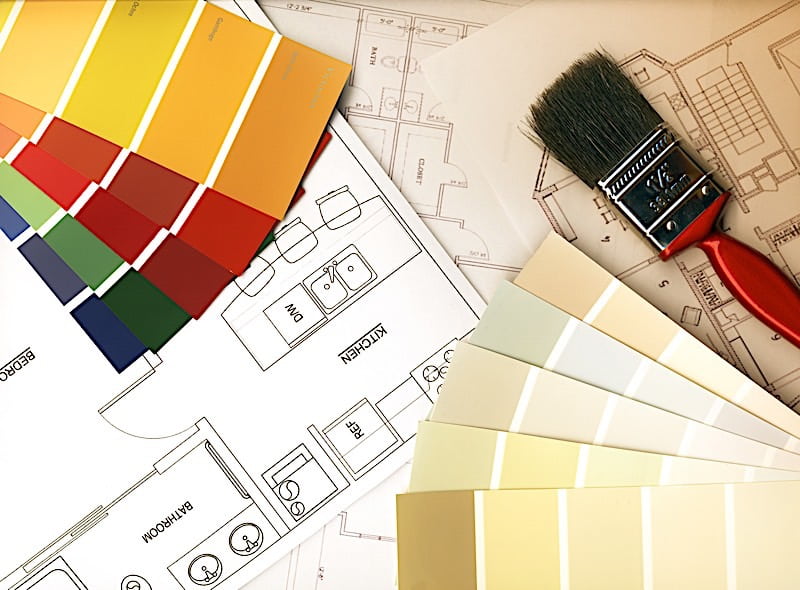There are many real estate exit strategies for investors to choose from. Not surprisingly, new investors are often most familiar with rehabbing a house. While this particular strategy requires the most work, the rewards are well worth it. Rehabbing houses remains to be one of the most lucrative real estate investing strategies. However, it does require time and acute attention to detail. Investors hoping to learn the intricacies of a truly profitable rehab will need to familiarize themselves with many skills.
Those who are familiar with this particular exit strategy have most likely reaped its rewards for years. In fact, rehabbing has long facilitated the largest real estate investing profits. More importantly: any investor willing to learn the process can experience similar profit margins. Please note, however, that while rehabbing does allow for sizable monetary gains, it is not a guarantee. The only way to mitigate risk and increase profitability is to study the rehab process in its entirety.
It can be difficult to decide whether or not this real estate exit strategy could be right for you. Ultimately, rehabbing can serve as a good investing strategy when:
- You do not need to be paid immediately.
- You are intent on generating brand awareness, as it is a prime marketing opportunity.
- There is a potential for large profit margins on a subject property.
- The property is a safe location.
- You have a trusted team to work with—this includes contractors, lenders, title company, etc.
What Does Rehabbing A House Mean?
The rehabbing definition is when an investor renovates a property to improve it. Rehabbing can be approached several ways but is most often purchased at a discounted price and renovated intending to resell. This process is also known as house flipping. As a real estate investing exit strategy, rehabbing can lead to high-profit margins. Rehabbing can also include property owners who renovate their homes for personal use or to increase property value.
[ Rental property investor, rehabber or wholesaler? Get to know which investing strategy is the best fit for YOU by attending our FREE online real estate class. ]

How To Start Rehabbing Houses
If you think rehabbing houses could be the right exit strategy for you, there are a few steps you can take to be sure. First, it is always a good idea to lay out your professional and financial goals. Ask yourself where you want to be in five, ten, or fifteen years and what type of money you need to create the lifestyle you want. Write your goals down as you go to get a clear picture of your ideal lifestyle. At the same time, try and reflect on your motivations. This can help guide your decision-making down the line.
After mapping out your goals, it’s important to understand your current strengths and weaknesses. Examine your existing skillset and take stock of your financial situation. Perhaps you excel at networking or are highly organized; these skills will help you determine where to start. Identifying your skills will also help you learn which areas to improve on.
Do not be intimidated if you feel like you have less than ideal finances as you prepare to start. There are several ways real estate investors can raise funding. For example, investors without significant funding can work with a private lender or business partner to get started. Be sure to read this article on raising capital for real estate to learn more.
Average Costs Of Rehabbing A House
The average costs of rehabbing a house range from $20,000 to $80,000, though the finished cost could be more. The biggest determining factor when pricing a rehab is the location, which impacts the cost of materials and labor. The age and size of a home will also influence the overall budget.
Certain renovation types can affect average costs as well. For example, structural changes such as foundation repairs or a new roof will be more costly. Kitchen and bathroom renovations are often in the middle range, while cosmetic fixes have a lower budget on average. Review estimates online when pricing your rehab project.
Rehabbing Properties In 7 Steps
It is important to understand that rehabbing is one of the most complex real estate exit strategies. There are so many components involved that risks may be hiding around every corner. Therefore, if you are new to the industry, you should always start with projects that require a minimal amount of work—this way, you are not immediately in unfamiliar territory that you are unable to navigate. Then, over time, as your knowledge and confidence are supplemented, you can begin to take on increasingly larger projects that ultimately prove to be more profitable.
The rehab process can be broken down into several stages, seven to be exact. We strongly advise you do the same for your rehab business, as it will help to streamline the entire campaign. It is important to have a proven system in place to save both time and money. The following provides a quick snapshot of the entire rehab strategy:
- Scope of Work Development: Draft a step-by-step checklist that itemizes exactly what your contractor needs to do throughout the entire property.
- Job Bidding and Contractor Selection: Let prospective contractors know you are not a retail customer by bringing in several to bid for you’ your business.
- Contract Communication at Signing: As an investor, it is important to protect yourself. Make sure the proper paperwork is signed before you start a rehab.
- Six Critical Documents: Make sure the following documents are signed: Independent Contractor Agreement, Scope of Work, Payment Schedule, Contractor Insurance Indemnification Form, W-9 Tax Form and the Final Unconditional Waiver of Lein.
- Managing the Rehab Process: At this stage you will be managing your contractors through the physical rehab.
- The Property Closeout: The property closeout must include a final walkthrough and the final payments to your contractor.
- Preparing to Sell: Get the property cleaned up as quickly as possible and ready to sell.
Types Of Rehabbed Properties
There are often several categories within a given real estate exit strategy, and rehabbing is no different. When it comes to a rehab project, there are three main types investors should be aware of:
- Personal
- Flip
- Rental
While each rehab type may suggest its own independent exit strategy, these approaches are synonymous. The same basic principles of renovating and improving a property will still apply. However, when it comes to each type of rehab, the way profits are made will be slightly different. A good way to think about it is by considering the final goal of the renovation. Keep reading to learn about each type of property rehab.
Personal
A personal rehab is exactly what it sounds like: a property is renovated for personal use. This type of project is when a homeowner makes improvements for their own benefit. They can be related to functionality, aesthetics and even boost property value. Personal rehabs are often referred to as home renovations or home improvement projects.
Personal rehabs can serve as a good starting point for homeowners interested in flipping houses. Homeowners can learn the ropes while overseeing a renovation within their own home before moving into purchasing and renovating other houses. In addition, personal rehabs can be a great place to form a relationship with contractors, learn about a scope of work, and even project management. An added benefit is that a personal rehab can be done without time constraints or other pressures.
Flip
If you’ve ever watched HGTV, you likely already know what house flipping is. This popular rehab strategy involves purchasing a house, renovating it, and then selling it quickly for a profit. The key to a successful flip often lies in securing a good purchase price and completing the rehab quickly to minimize holding costs. When it cHowever, when to a flip, time is money. Therefore, it is imperative to complete a flip in the shortest amount of time possible to reduce the costs of owning and operating the property.
Investors interested in successful house flipping should understand their local market area and how it works. This strategy also requires a working knowledge of the industry and rehabbing process. A great place to start flipping houses can be by shadowing another investor through the process. Ask your mentor or another investor in your network if you can tag along with their next deal. This can provide a first-hand look at the importance of a good team, a quick timeline, and a healthy market.
Rental
This type of rehab project involves renovating a property to rent it out to future tenants. As you might guess, this process is very similar to a rehab and flip scenario, but instead of selling the property, you will rent it to a prospective tenant. Many investors will often start by flipping houses and then work up to adding a rental into their portfolio. This is a great way to earn a steady, passive income.
If you are unsure of whether or not to sell or rent a potential rehab property, look at the current market conditions. Pay attention to average rent, time on the market, and what inventory looks like in a given area. Additionally, before renting a rehab property, you will need to determine whether or not you want to manage the tenants yourself or work with a property manager. Ultimately, deciding between a flip and a rental will come down to your specific market area and real estate investing goals.

Working With Professionals
If you feel overwhelmed by the amount of work needed to rehab a house yourself, it may be time to consult professionals. It is highly recommended to have a home inspection done before closing. If not, have an inspection done before rehabbing. A home inspection report will be an essential reference point professionals will use to determine the major areas that absolutely require rehabbing.
When rehabbing a house, professionals you can consult include architects, contractors, engineers, and interior designers. Larger projects, such as taking down walls, are usually not DIY projects, and professionals must be consulted for safety and to avoid causing major damage.
Rehab vs. Fixer-Upper
Rehab and fixer-upper are commonly used interchangeably, but they don’t capture the same level of work on a property. A rehab project generally involves a full renovation, and the help of professionals. If you need to renovate a bathroom, kitchen, or any structural elements the property is likely a rehab. In many cases, rehab projects take properties that are not up to code and make them habitable before they can be sold.
A fixer-upper refers to more casual renovation projects, and generally sticks to cosmetic fixes. Fixer-upper projects are more amateur friendly and involve lower technical knowledge to improve the property. A fixer-upper could include new paint, flooring, light fixtures, or other minor changes before being sold. Homeowners can typically live in a fixer-upper while making these changes.
Summary
Rehabbing a house is one of the most popular exit strategies in real estate investing, and rightfully so. Real estate investors of all backgrounds and starting points have come to know the benefits of real estate rehabs, and there is no reason you can’t either. To get started rehabbing houses, carefully layout your goals and identify which rehab type will best align with your situation. Learn the process before taking on your first project, and don’t be afraid to start small—there is no reason you can’t be successful rehabbing houses.